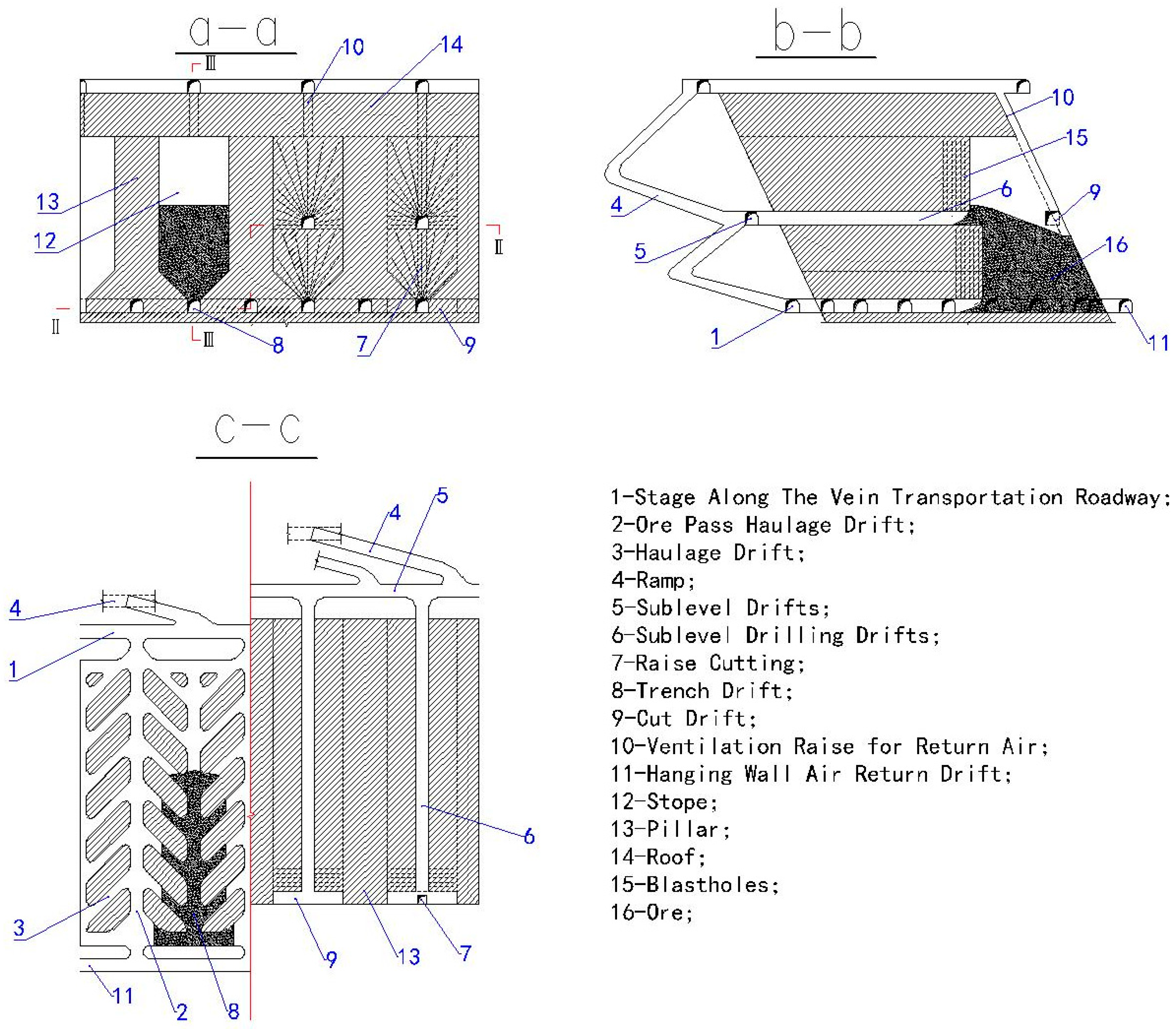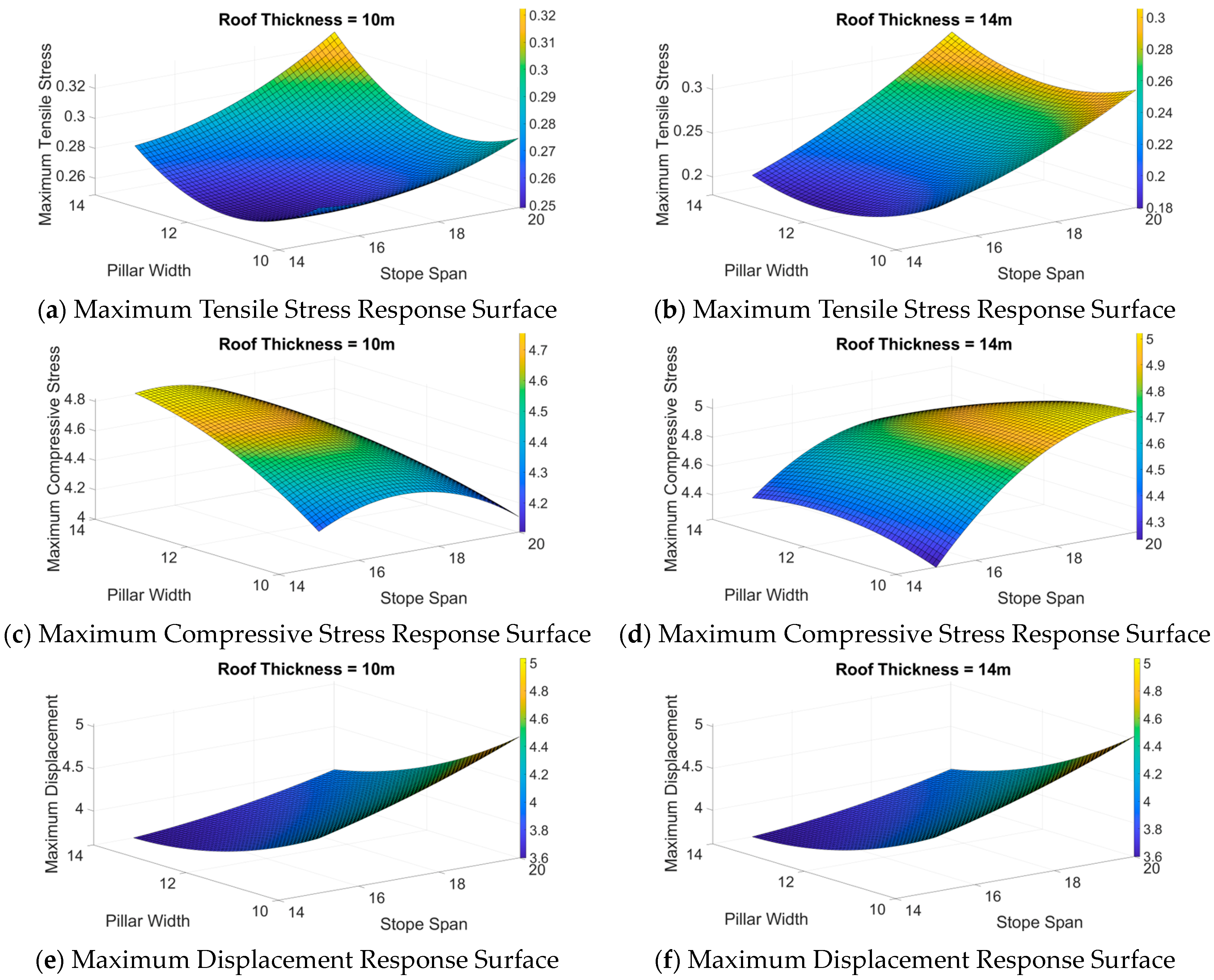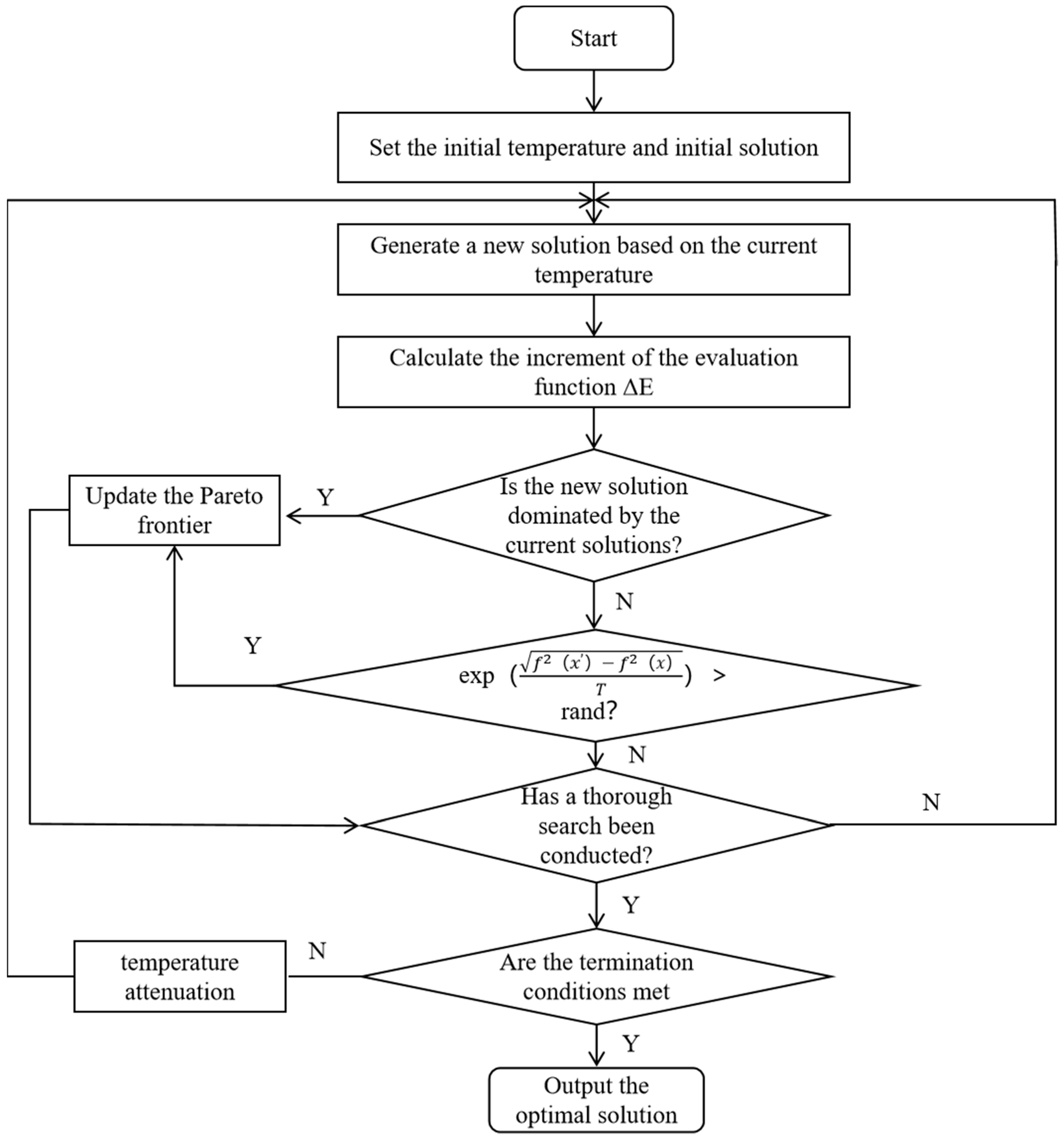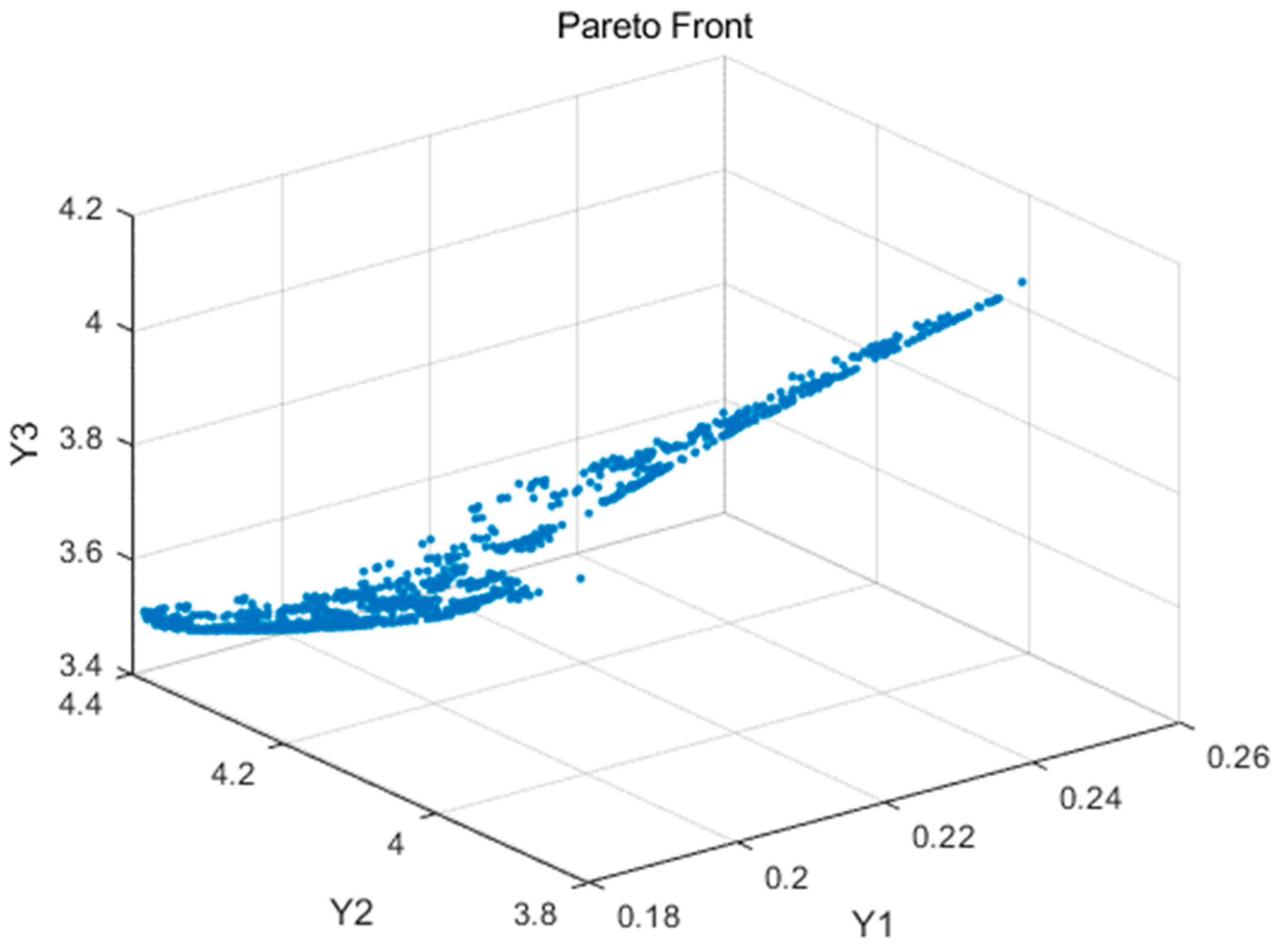Optimization of Stope Structural Parameters for Steeply Dipping Thick Ore Bodies: Based on the Simulated Annealing Algorithm
Abstract
:1. Introduction
2. Materials and Methods
2.1. Materials
2.2. Methods
2.2.1. Pillar Stability Calculation
2.2.2. Roof Stability Calculation
2.3. Numerical Simulation Experiment
2.3.1. Basic Assumptions and Initial Geostress Field
2.3.2. Model Construction and Calculation Results
2.4. Response Surface Methodology
- Maximum Tensile Stress (Y1): R2 = 0.98.
- Maximum Compressive Stress (Y2): R2 = 0.91.
- Maximum Vertical Displacement (Y3): R2 = 0.96.
- Effect of Stope Span on Compressive and Tensile Stresses in the Stope: As the stope span increases, the stability of the surrounding rock gradually decreases, weakening the load-bearing capacity of the roof and causing a redistribution of stresses above the stope. A larger span increases tensile stress in the middle of the roof, potentially triggering bending and tensile effects, similar to the “arching effect” in structural mechanics. With a larger span, stress concentrates in the central region, increasing tensile stress, especially in rock structures where cracks and fractures are more likely to form, leading to stress concentration. As the span grows, the roof’s load-bearing capacity further diminishes, reducing overall stiffness and increasing compressive stress in the support zones. Larger spans also lead to compressive stress concentration near the center and support points, potentially causing local stress instability and rock failure. In general, the greater the span, the more likely bending and collapse occur in the roof, increasing maximum compressive stress and reducing structural stability overall.
- Effects of Pillar Width on Compressive and Tensile Stress in the Stope: When the pillar width is small, the support strength and stiffness of the pillar are insufficient to effectively resist the self-weight of the roof and external loads, leading to significant deformation of the roof and concentration of tensile stress in certain areas. As the size of the pillar increases, their load-bearing capacity and stiffness improve, allowing for better resistance against roof subsidence and deformation, which in turn reduces the deflection of the roof and the tensile stress resulting from that deflection. However, when the pillar reaches a critical size, the support strength exhibits a saturation effect, and further increases in pillar size yield minimal improvement in load-bearing capacity. At the same time, the increase in the weight of the pillar causes the roof to bear greater downward forces, thereby increasing tensile stress in the roof. When the pillar width is small, the support effect is relatively good, resulting in a more uniform distribution of compressive stress in the roof. However, as the pillar width increases, the support capacity gradually weakens, leading to the concentration of compressive stress near the support points and increasing the risk of localized compressive stress. When the pillar width reaches its critical size, the support stiffness is significantly insufficient, causing further increases in compressive stress in the central area of the roof, which may trigger local instability and rock failure.
- Effects of Roof Thickness on Compressive and Tensile Stress: Thicker roofs possess greater stiffness, enabling them to better resist bending deformation and reduce the concentration of tensile stress, particularly diminishing the tensile effects in the central region of the roof. Consequently, thick roofs can effectively distribute tensile stress under support conditions, lowering the risk of structural instability. In contrast, thinner roofs have lower stiffness, making them more susceptible to larger bending and tensile stress concentrations, which increases the risk of fissures and cracking in the central area. Additionally, the increased stiffness of thicker roofs helps to minimize stope deformation and decrease compressive stress concentrations, resulting in a more uniform distribution of maximum compressive stress and an overall reduction in compressive stress.
- Effects of Stress on Stope Displacement: In the stope, the distribution of stress directly affects displacement. As the support conditions or external loads change, an increase in stress within the stope can lead to greater plastic deformation of the rock mass, resulting in increased displacement.
2.5. Multi-Objective Optimization Using Pareto Simulated Annealing Algorithm
3. Results
4. Discussion
5. Conclusions
- (1)
- According to the K. Kgel strength formula, the safety coefficient of the pillar span should be greater than 1. The average span of the stope span is determined to be 15–20 m, and the width of the pillar span is 10–14 m. The thickness of the roof is calculated using the limit analysis method, and the thickness of the roof is calculated to be 10–14 m. Basic data support is provided for the subsequent optimization of the design.
- (2)
- The maximum tensile stress, maximum compressive stress, and maximum vertical displacement under different quarry parameters were obtained by numerical simulation through the means of the central composite test. The second-order response surface model between different parameters and each mechanical response was established, and the fitting R2 coefficients of each model were 0.98, 0.91, and 0.96 respectively, which indicated that the model fit was high and could be used for parameter optimization.
- (3)
- The SA algorithm based on the Pareto optimal solution set is applied to the multi-objective optimization problem of the response surface, and 15 non-inferior solutions are obtained for the structural parameters of the mining hall. According to the actual needs of the project and relevant principles, a stope span of 15.0 m, pillar span of 10.0 m, and thickness of the roof slab of 11.9 m are taken as the optimal structural parameters for mining.
Author Contributions
Funding
Institutional Review Board Statement
Informed Consent Statement
Data Availability Statement
Acknowledgments
Conflicts of Interest
References
- Huang, M.; Wang, X.; Qiu Jixiang Gu Yazhou Cai, S.; Huang, M. Optimization of Mining Method for Stage Open-Stoping with Backfill of Inclined Medium-Thick Orebody. J. Min. Sci. Technol. 2024, 9, 483–492. [Google Scholar]
- Sun, M.; Ren, F.; Ding, H. Optimization of Stope Structure Parameters Based on the Mined Orebody at the Meishan Iron Mine. Adv. Civ. Eng. 2021, 2021, 8052827. [Google Scholar] [CrossRef]
- Sandanayake, D.S.S.; Topal, E.; Asad, M.W.A. A Heuristic Approach to Optimal Design of an Underground Mine Stope Layout. Appl. Soft Comput. 2015, 30, 595–603. [Google Scholar] [CrossRef]
- Lan, M.; Liu, Z.X.; Li, X.B.; Liu, Q. Stope Parameters Optimization of Level Afterwards Back-Filling Approach with Medium-Deep Hole Caving. J. Cent. South Univ. (Sci. Technol.) 2018, 49, 933–939. [Google Scholar]
- Zhou, X.; Zhao, X.; Qu, Q.; Shi, J. Stope Structural Parameters Design Towards Green and Deep Mining: A Review. Processes 2023, 11, 3125. [Google Scholar] [CrossRef]
- Mawdesley, C.; Trueman, R.; Whiten, W.J. Extending the Mathews Stability Graph for Open–Stope Design. Min. Technol. 2001, 110, 27–39. [Google Scholar] [CrossRef]
- Nan, S.; Gao, Q.; Liu, Z. Numerical Simulation of Fluid-Solid Coupling in Surrounding Rock and Parameter Optimization for Filling Mining. Procedia Eng. 2011, 26, 1639–1647. [Google Scholar]
- Cui, X.; Yang, S.; Zhang, N.; Zhang, J. Optimization of Stope Structure Parameters by Combining Mathews Stability Chart Method with Numerical Analysis in Halazi Iron Mine. Heliyon 2024, 10, e26045. [Google Scholar] [CrossRef]
- Hu, J.H.; Qin, Y.G.; Ren, Q.F.; Yang, D.J. Bearing Mechanism and Thickness Optimization of Ore Roof in Bauxite Stope. Trans. Nonferrous Met. Soc. China 2022, 32, 285–295. [Google Scholar]
- Chen, S.; Wu, A.; Wang, Y.; Cheng, X. Multi-Objective Optimization of Stope Structure Parameters in Broken Rock Conditions Using Grey Relational Analysis. Arch. Min. Sci. 2018, 63, 269–282. [Google Scholar] [CrossRef]
- Foroughi, S.; Hamidi, J.K.; Monjezi, M.; Nehring, M. The Integrated Optimization of Underground Stope Layout Designing and Production Scheduling Incorporating a Non-Dominated Sorting Genetic Algorithm (Nsga-Ii). Resour. Policy 2019, 63, 101408. [Google Scholar] [CrossRef]
- Liu, X.; Liu, Z.X.; Liu, A.H.; Li, W. Chaotic Optimization of Structural Parameters in Gold Mining Field. J. Min. Saf. Eng. 2010, 27, 548–552. [Google Scholar]
- Zhou, K.; Wang, X.; Gao, F. Stope Structural Parameters Optimization Based on Strength Reduction and Ann-Ga Model. J. Cent. South Univ. (Sci. Technol.) 2013, 44, 2848–2854. [Google Scholar]
- Duh, J.D.; Brown, D.G. Knowledge-Informed Pareto Simulated Annealing for Multi-Objective Spatial Allocation. Comput. Environ. Urban Syst. 2007, 31, 253–281. [Google Scholar] [CrossRef]
- Li, C.; Mei, X.; Zhang, J. Application of Supervised Random Forest Paradigms Based on Optimization and Post-Hoc Explanation in Underground Stope Stability Prediction. Appl. Soft Comput. 2024, 154, 111388. [Google Scholar] [CrossRef]
- Matamoros ME, V.; Kumral, M. Heuristic Stope Layout Optimisation Accounting for Variable Stope Dimensions and Dilution Management. Int. J. Min. Miner. Eng. 2017, 8, 1–18. [Google Scholar] [CrossRef]
- Nhleko, A.S.; Tholana, T.; Neingo, P.N. A Review of Underground Stope Boundary Optimization Algorithms. Resour. Policy 2018, 56, 59–69. [Google Scholar] [CrossRef]
- Lee, K.S.; Geem, Z.W. A New Meta-Heuristic Algorithm for Continuous Engineering Optimization: Harmony Search Theory and Practice. Comput. Methods Appl. Mech. Eng. 2005, 194, 3902–3933. [Google Scholar] [CrossRef]
- Rardin, R.L.; Uzsoy, R. Experimental Evaluation of Heuristic Optimization Algorithms: A Tutorial. J. Heuristics 2001, 7, 261–304. [Google Scholar] [CrossRef]
- Hou, J.; Li, G.; Wang, H.; Hu, N. Genetic Algorithm to Simultaneously Optimise Stope Sequencing and Equipment Dispatching in Underground Short-Term Mine Planning under Time Uncertainty. Int. J. Min. Reclam. Environ. 2020, 34, 307–325. [Google Scholar] [CrossRef]
- Zhai, S.; Gao, Q. Design and Optimization of Stope Parameters Based on Evolutionary Algorithm. J. Eng. Geol. 2015, 23, 699–705. [Google Scholar]
- Martens, D.; De Backer, M.; Haesen, R.; Vanthienen, J.; Snoeck, M.; Baesens, B. Classification with Ant Colony Optimization. IEEE Trans. Evol. Comput. 2007, 11, 651–665. [Google Scholar] [CrossRef]
- Leite, W.L.; Shen, Z.; Marcoulides, K.; Fisk, C.L.; Harring, J. Using Ant Colony Optimization for Sensitivity Analysis in Structural Equation Modeling. Struct. Equ. Model. A Multidiscip. J. 2022, 29, 47–56. [Google Scholar] [CrossRef]
- Vasile, A.; Coropețchi, I.C.; Sorohan, Ș.; Picu, C.R.; Constantinescu, D.M. A Simulated Annealing Algorithm for Stiffness Optimization. Procedia Struct. Integr. 2022, 37, 857–864. [Google Scholar] [CrossRef]
- Huri, D.; Mankovits, T. Surrogate Model-Based Parameter Tuning of Simulated Annealing Algorithm for the Shape Optimization of Automotive Rubber Bumpers. Appl. Sci. 2022, 12, 5451. [Google Scholar] [CrossRef]
- Matamoros, M.E.V. A Novel Stope Layout Optimization Based on Robust Genetic Algorithms. Ph.D. Thesis, McGill University, Montreal, QC, Canada, 2018. [Google Scholar]
- Saghatforoush, A.; Monjezi, M.; Shirani Faradonbeh, R.; Jahed Armaghani, D. Combination of Neural Network and Ant Colony Optimization Algorithms for Prediction and Optimization of Flyrock and Back-Break Induced by Blasting. Eng. Comput. 2016, 32, 255–266. [Google Scholar] [CrossRef]
- Li, J.; He, Y.; Chang, L. Optimization of Stereo Parking Allocationbased on Improved Simulated Annealing Algorithm. J. Chongqing Univ. Technol. (Nat. Sci.) 2020, 34, 183–191. [Google Scholar]
- Blanzeisky, W.; Cunningham, P. Using Pareto Simulated Annealing to Address Algorithmic Bias in Machine Learning. Knowl. Eng. Rev. 2022, 37, e5. [Google Scholar] [CrossRef]
- Alkhamis, A.K.; Hosny, M. A Multi-Objective Simulated Annealing Local Search Algorithm in Memetic Censga: Application to Vaccination Allocation for Influenza. Sustainability 2023, 15, 15347. [Google Scholar] [CrossRef]
- Sun, X.; Guo, S.; Guo, J.; Du, B.; Yang, Z.; Wang, K. A Pareto-Based Hybrid Genetic Simulated Annealing Algorithm for Multi-Objective Hybrid Production Line Balancing Problem Considering Disassembly and Assembly. Int. J. Prod. Res. 2024, 62, 4809–4830. [Google Scholar] [CrossRef]
- Ma, H.T. Study on Method of Risk Classification and Instability Forecasting of Goaf; University of Science and Technology Beijing: Beijing, China, 2015. [Google Scholar]
- Niu, X. Study on Roofs’ Stability of Cavities Under Open-Pit Mine; Changsha Institute of Mining Research Co., Ltd.: Changsha, China, 2013. [Google Scholar]
- Wang, X.; Wu, X.; Sun, G. Numerical Simulation Analysis of Goafs Stability in Calcite Mine. Metal Mine 2015, 44, 24–27. [Google Scholar]
- Zhang, W. Stability Analysis of Goaf and Optimization of Stope Parameters in a Calcite Mine. Mod. Minin 2020, 36, 80–83. [Google Scholar]
- Allaix, D.L.; Carbone, V.I. An Improvement of the Response Surface Method. Struct. Saf. 2011, 33, 165–172. [Google Scholar] [CrossRef]
- Shaibu, A.B.; Cho, B.R. Another View of Dual Response Surface Modeling and Optimization in Robust Parameter Design. Int. J. Adv. Manuf. Technol. 2009, 41, 631–641. [Google Scholar] [CrossRef]
- Trinh, T.K.; Kang, L.S. Application of Response Surface Method as an Experimental Design to Optimize Coagulation Tests. Environ. Eng. Res. 2010, 15, 63–70. [Google Scholar] [CrossRef]
- Xiao, X.W.; Xiao, D.; Lin, J.G.; Xiao, Y.F. Overview on Multi-Objective Optimization Problem Research. Appl. Res. Comput. 2011, 28, 805. [Google Scholar]
- Mao, J.; Li, Q.; Xie, M.; Cao, J. Multi-Objective Optimization Software Development and Application. Chin. J. Eng. Des. 2015, 22, 262–268. [Google Scholar]
- Wang, Z.; Rangaiah, G.P. Application and Analysis of Methods for Selecting an Optimal Solution from the Pareto-Optimal Front Obtained by Multiobjective Optimization. Ind. Eng. Chem. Res. 2017, 56, 560–574. [Google Scholar] [CrossRef]
- Busetti, F. Simulated Annealing Overview. World Wide Web. Available online: https://r.search.yahoo.com/_ylt=AwrgxRIYzSpnLxMD4K9XNyoA;_ylu=Y29sbwNncTEEcG9zAzEEdnRpZAMEc2VjA3Ny/RV=2/RE=1732067864/RO=10/RU=http%3a%2f%2fwww.geocities.ws%2ffrancorbusetti%2fsaweb.pdf/RK=2/RS=R0RpaGrKiPpI6GnPOqrny1Dhiu8- (accessed on 12 April 2003).





| Rock Type | Tensile Strength σt/MPa | Compressive Strength σc/MPa | Elastic Modulus Em/GPa | Cohesion Cm/KPa | Friction Angle φ (°) | Density γ/g/cm3 | Poisson’s Ratio |
|---|---|---|---|---|---|---|---|
| Ore Body | 0.341 | 5.973 | 8.867 | 1086 | 48.90 | 2.65 | 0.23 |
| Limestone | 3.063 | 37.342 | 24.75 | 6122 | 52.80 | 2.70 | 0.21 |
| Pillar Width | 10 m | 11 m | 12 m | 13 m | 14 m | |
|---|---|---|---|---|---|---|
| Stope Span | ||||||
| 15 m | 1.276 | 1.416 | 1.553 | 1.689 | 1.823 | |
| 16 m | 1.235 | 1.372 | 1.507 | 1.641 | 1.772 | |
| 17 m | 1.196 | 1.330 | 1.464 | 1.595 | 1.725 | |
| 18 m | 1.16 | 1.292 | 1.423 | 1.553 | 1.681 | |
| 19 m | 1.127 | 1.256 | 1.385 | 1.513 | 1.640 | |
| 20 m | 1.096 | 1.223 | 1.35 | 1.476 | 1.601 | |
| Boundary Constraint Forms | C | Cn |
|---|---|---|
| Four-edge fixed slab | 4 | 1 |
| Three-sided fixed and one-sided simply supported | 2 + |
| Equivalent Coefficient C | Equivalent Coefficient Cn | Stope Length L (m) | Stope Span L (m) | Roof Tensile Strength (MPa) | Roof Rock Bulk Density (KN/m3) | (Boundary Constraint Forms) |
|---|---|---|---|---|---|---|
| 4 | 1 | 65 | 15–20 | 0.501 | 26.5 | Four-edge fixed slab |
| 3.414 | 1.172 | 65 | 15–20 | 0.501 | 26.5 | Three-sided Fixed and one-sided simply supported |
| (m) | 15 | 16 | 17 | 18 | 19 | 20 | Boundary Constraint Forms |
|---|---|---|---|---|---|---|---|
| Roof Safety Thickness (m) | 10.13 | 10.71 | 11.28 | 11.84 | 12.39 | 12.93 | Four-edge fixed slab |
| 11.08 | 11.72 | 12.35 | 12.06 | 12.97 | 13.58 | Three-sided fixed and one-sided simply supported |
| Experimental Schemes | Stope Span /m | Pillar Span /m | Roof Thickness /m | Maximum Tensile Stress/Mpa | Maximum Compressive Stress/Mpa | Maximum Vertical Displacement/mm |
|---|---|---|---|---|---|---|
| 1 | 15 | 10 | 10 | 0.183 | 4.873 | 4.154 |
| 2 | 15 | 10 | 14 | 0.238 | 4.662 | 4.665 |
| 3 | 15 | 12 | 12 | 0.198 | 4.886 | 4.126 |
| 4 | 15 | 14 | 10 | 0.243 | 4.299 | 3.728 |
| 5 | 15 | 14 | 14 | 0.204 | 4.636 | 3.810 |
| 6 | 17.5 | 10 | 12 | 0.293 | 5.245 | 4.898 |
| 7 | 17.5 | 12 | 10 | 0.296 | 5.009 | 4.424 |
| 8 | 17.5 | 12 | 12 | 0.297 | 4.910 | 4.829 |
| 9 | 17.5 | 12 | 14 | 0.259 | 4.675 | 4.613 |
| 10 | 17.5 | 14 | 12 | 0.316 | 5.225 | 4.002 |
| 11 | 20 | 10 | 10 | 0.308 | 5.421 | 5.090 |
| 12 | 20 | 10 | 14 | 0.292 | 5.120 | 5.249 |
| 13 | 20 | 12 | 12 | 0.330 | 5.191 | 4.646 |
| 14 | 20 | 14 | 10 | 0.388 | 5.180 | 4.363 |
| 15 | 20 | 14 | 14 | 0.337 | 5.365 | 4.278 |
| Serial Number | X1 | X2 | X3 | Y1 | Y2 | Y3 |
|---|---|---|---|---|---|---|
| 1 | 15.003 | 10.000 | 11.901 | 0.251 | 3.916 | 4.132 |
| 2 | 15.000 | 10.005 | 12.129 | 0.247 | 3.916 | 4.114 |
| 3 | 15.000 | 10.020 | 12.112 | 0.247 | 3.919 | 4.111 |
| 4 | 15.000 | 10.049 | 12.078 | 0.247 | 3.923 | 4.105 |
| 5 | 15.002 | 10.053 | 12.078 | 0.247 | 3.925 | 4.104 |
| 6 | 15.003 | 10.043 | 12.100 | 0.247 | 3.923 | 4.105 |
| 7 | 15.000 | 10.001 | 12.178 | 0.247 | 3.917 | 4.112 |
| 8 | 15.000 | 10.000 | 12.180 | 0.247 | 3.917 | 4.112 |
| 9 | 15.000 | 10.000 | 12.191 | 0.247 | 3.917 | 4.112 |
| 10 | 15.000 | 10.073 | 12.093 | 0.246 | 3.928 | 4.097 |
| 11 | 15.000 | 10.070 | 12.100 | 0.246 | 3.927 | 4.097 |
| 12 | 15.007 | 10.031 | 12.220 | 0.245 | 3.925 | 4.101 |
| 13 | 15.000 | 10.058 | 12.233 | 0.244 | 3.928 | 4.091 |
| 14 | 15.000 | 10.087 | 12.195 | 0.244 | 3.932 | 4.086 |
| 15 | 15.002 | 10.102 | 12.184 | 0.244 | 3.935 | 4.082 |
Disclaimer/Publisher’s Note: The statements, opinions and data contained in all publications are solely those of the individual author(s) and contributor(s) and not of MDPI and/or the editor(s). MDPI and/or the editor(s) disclaim responsibility for any injury to people or property resulting from any ideas, methods, instructions or products referred to in the content. |
© 2024 by the authors. Licensee MDPI, Basel, Switzerland. This article is an open access article distributed under the terms and conditions of the Creative Commons Attribution (CC BY) license (https://creativecommons.org/licenses/by/4.0/).
Share and Cite
Du, H.; Li, X.; Huang, X.; Yang, Y.; Duan, S.; Su, T.; Yuan, X. Optimization of Stope Structural Parameters for Steeply Dipping Thick Ore Bodies: Based on the Simulated Annealing Algorithm. Appl. Sci. 2024, 14, 11597. https://doi.org/10.3390/app142411597
Du H, Li X, Huang X, Yang Y, Duan S, Su T, Yuan X. Optimization of Stope Structural Parameters for Steeply Dipping Thick Ore Bodies: Based on the Simulated Annealing Algorithm. Applied Sciences. 2024; 14(24):11597. https://doi.org/10.3390/app142411597
Chicago/Turabian StyleDu, Han, Xuefeng Li, Xuxing Huang, Yihao Yang, Shanda Duan, Tianlong Su, and Xuzhao Yuan. 2024. "Optimization of Stope Structural Parameters for Steeply Dipping Thick Ore Bodies: Based on the Simulated Annealing Algorithm" Applied Sciences 14, no. 24: 11597. https://doi.org/10.3390/app142411597
APA StyleDu, H., Li, X., Huang, X., Yang, Y., Duan, S., Su, T., & Yuan, X. (2024). Optimization of Stope Structural Parameters for Steeply Dipping Thick Ore Bodies: Based on the Simulated Annealing Algorithm. Applied Sciences, 14(24), 11597. https://doi.org/10.3390/app142411597




